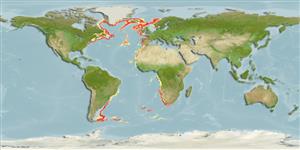| Native range | All suitable habitat | Point map | Year 2100 |

|
| Centroscyllium fabricii AquaMaps Data sources: GBIF OBIS |
Length at first maturity
Lm ?, range 58 - 70 cm
Human uses
Fisheries: subsistence fisheries
Phylogenetic diversity index
(Ref. 82805)
PD50 = 0.5078 many relatives (e.g. carps) 0.5 - 2.0 few relatives (e.g. lungfishes)
Trophic Level
(Ref. 69278)
3.8 ±0.3 se; Based on diet studies.
Resilience
(Ref. 69278)
Low, minimum population doubling time 4.5 - 14 years (Fec=14)